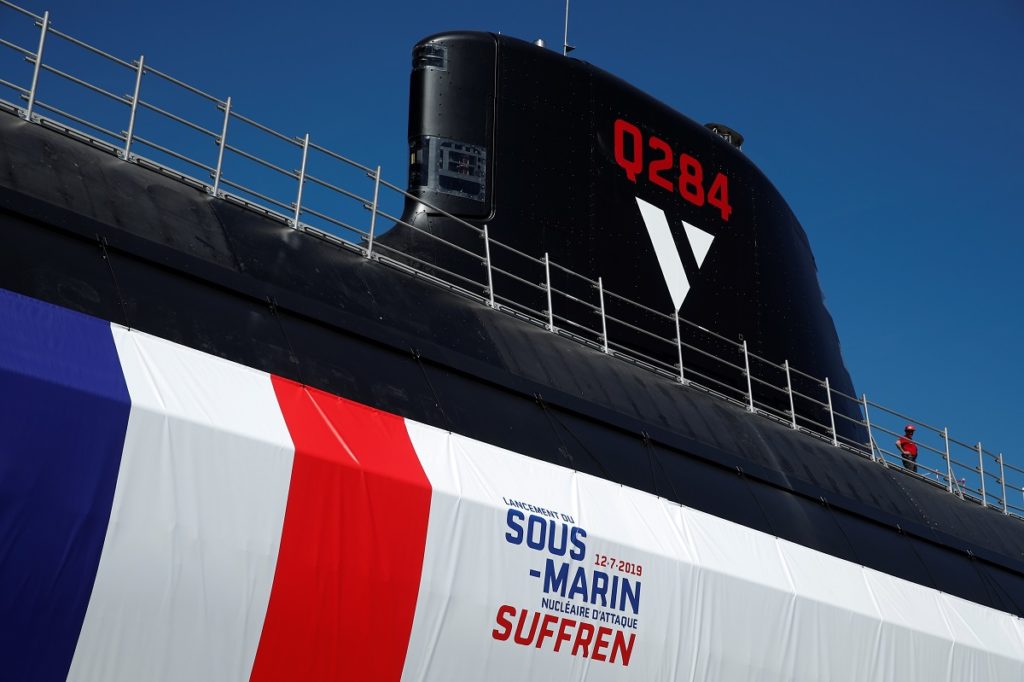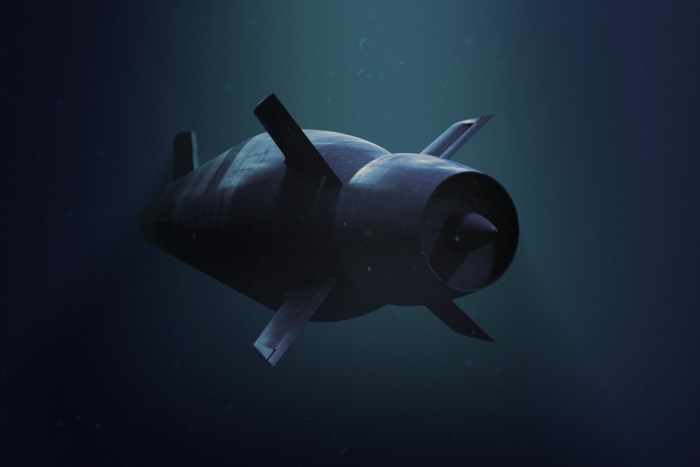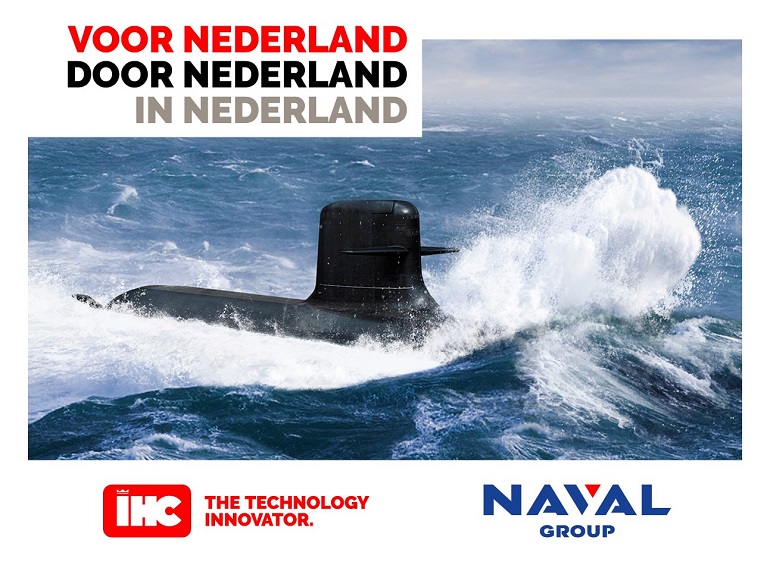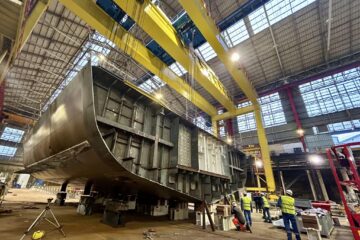On July 12, Naval Group and the Marine Nationale unveiled for the first time the Suffren, first ship of the new class of SSN for the French Navy. The event was held in presence of French President Emmanuel Macron and Minister of Defense Florence Parly. Brazilian Navy Commander Ilques Barbosa along with Australian Minister of Defence Linda Reynolds also attended the unveiling of the first ship of the Barracuda program.
Officially displayed as the launch of the Suffren, the ceremony really only covered its public unveiling. The ship will not touch water until later this summer. After that, the ship’s nuclear reactor will be fueled in September, then allowing the submarine to start its tests at sea. Those tests are due to last less than a year. A real challenge for Naval Group, the DGA (defence procurement agency) and the French Navy. According to Vincent Martinot-Lagarde, Naval Group’s director of the Barrracuda program, this very tight schedule will be complied by using proven technologies when possible and intensive simulation and ground testing for the new generation of equipment aboard the submarine.

Commander Axel Roche. All are experienced submariners because the trials of a
new submarine require a strong underwater culture. The average age of the crew is 33 years old and they have 8,500 hours of diving on average (compared to
28 years and 6,500 hours aboard Rubis-class SSN).
A next generation of nuclear submarines
Comparing to the current generation of French SSN, the Rubis-class, the Suffren-class marks a qualitative leap in performances and technologies.
- It features a new hybrid steam/electric propulsion that allows high speed and improved noise reduction.
- It can be fitted with a Dry Deck Shelter. Designed by Naval Group, the DDS will be around 15m long and weight 43 tons. Two of them have been procured to equip the 6-ships fleet of Barracuda.
- The Barracuda submarines are using X rudders and retractable forward sail planes, for better maneuverability, improved safety in shallow waters and reduced noise at high speed.
- The ship is fully digitized. Automation reduces human resources in every subsystem of the ship. Even if the Suffren is twice as big as the Rubis, it will have a slightly smaller crew.

But the new design also adopts some of the equipment and systems already operational on the most recent submarines in the French inventory, the Le Triomphant-class of SSBN that were commissioned between 1997 and 2010.
- The Suffren’s Combat Management System is the SYCOBS, for Système de Combat Commun Barracuda et SNLE (Joint Combat System for Barracuda and SSBN). First seen on the Terrible, the SYCOBS was later introduced on the remaining Triomphant-class ships during their retrofit. Using a similar CMS reduces the risks during the Barracuda development and facilitates transfer of crew members between SSN and SSBN.
- The nuclear power-plant of the Suffren is an improved, smaller derivative of the K15 used on the Triomphant-class .
- The Barracuda propeller is a pump-jet based on the one used on the Le Triomphant. Overall, most of the noise reduction systems on the Suffren derive from the R&D phase of the Le Triomphant program.

Improved capacities for the French navy
The Suffren history started in 1992 with the SMAF program (sous-marin d’attaque future, Future Attack Submarine) which became the Barracuda program in 1998, when the first definition and feasibility studies where launched. In 2007, industrialization of the first Barracuda began. From the end of the 1990’s, the ship design has grown from 88m to 99m in length, and from 4000 to 5300 tons in displacement, in order to accommodate new capabilities.
Indeed, the Barracuda was designed in order to replace the Rubis-class in its three main missions:
- Protection of the French SSBN,
- Escort of the aircraft carrier and amphibious groups,
- Intelligence gathering.
But early during the design phase the Marine Nationale required new capacities to be added in the design. With a longer hull, the Barracuda benefits from a higher top speed, which is still classified, but set beyond 25kt. Moreover, it integrates new tactical capabilities that will be a first for the French Navy:
- The Barracuda will carry naval cruise missiles. Launched from the torpedo tube, the NCM has a range of more than 1000km. While the FREMM frigates already carry the NCM, sub-launched missiles benefit from greater tactical surprise and flexibility.
- The ships are able to embark up to 15 special operation forces (the famous Commandos Marine). While the Rubis-class is only able to deploy a handful of swimmers from the torpedo tubes, fully-equipped frogmen onboard the Suffren will either be deployed from the embedded air-lock or from a removable Dry Deck Shelter. This DDS then allows the special operation forces to use heavier equipment, including surface and sub-surface vehicles.
When French attack submarines are operational with cruise missiles and DDS, the Marine Nationale will then master tactical capabilities than only the US Navy and Royal Navy nowadays possess in NATO.

French Navy continues to improve its nuclear powered submarine fleet
French deterrent force mainly relies on the SSBN fleet of 4 ships. The first nuclear submarine class build in France, Le Redoutable, was designed to serve 20 years. They were replaced between 1997 and 2010 by four Le Triomphant-class ships, designed for 30 years of operations, and set for replacement in the 2030ies by the SNLE-3G (third generation of SSBN).
During the 20-30 years that separate each class of SSBN, it is of a strategic interest that the French Navy and shipbuilder Naval Group stay at the forefront of nuclear-powered ships design and industrialization (both submarines and aircraft carriers). That’s where the Barrracuda program came into play: right between two SSBN programs, just like the Rubis-class did 30 years ago. The program itself maintains French sovereignty over its industrial and technological defense base regarding nuclear powered vessels.
The Barracuda ships are also a major part of the deterrent force. Even if they don’t carry any nuclear weapon, they are a key element in the protection of the SSBN fleet at sea. Moreover, most of the officer and all the commanders of the French SSBNs used to serve aboard SSNs. Having a state of the art SSN fleet is therefore necessary to keep the training and tactical abilities of the SSBN crews at their best.
Compared to conventional propulsion submarines or even to the previous Rubis-class, the new Barracuda SSN displays impressive performances, mainly due to its powerful propulsion.

The nuclear reactor aboard the Suffren is a new variant of the K15 pressurized water reactor used on the SSBN fleet and the CVN Charles De Gaulle. Very compact (hence the “K”), it fits in the 8,8 meter width hull, its operational power delivery and even its full name (that indicates its power, K15 standing for 150 megawatts) are classified. The nuclear boiler aboard the Suffren weights around 400 tons and occupies a 10m section of the submarine.
Contrary to the US Navy, French naval nuclear reactors are using the same nuclear fuel as in the civilian power plants. This allows a cheaper design, security in the supply chain and more safety aboard the ship. But the Suffren won’t be able to spend its entire lifetime with the same fuel in the reactor’s core. The Barracuda ships will have to refuel every ten years. The previous generations of nuclear submarines, the Rubis-class, had to be refueled every 5 years when they were first commissioned back in the 1980ies.
The design of the new nuclear reactor was entrusted to the Atomic Energy and Alternative Energies Commission (CEA) with TechnicAtome and Naval Group as prime contractors. With more than 50 years of experience, TechnicAtome was in charge of designing and building the nuclear propulsion systems, support systems and nuclear cores. Naval Group was in charge of the reactor pressure tank, steam generator and overall integration.
The nuclear reactor transmits the heat energy of its core through a nuclear steam supply system. The steam produced, free of radiation, is then used to directly power the two propulsion turbines and to power the two turbo-generators. These generators supply the ship in electricity, including the two very quiet electric motors used for low and tactical speeds.
Thanks to its nuclear propulsion system and its pump-jet propeller, the Suffren will be able to be deployed in silence at fast speed to virtually anywhere in the planet. The only limitation in its underwater operations is the food supply. While the Rubis-class typical autonomy was 45 days, the Suffren won’t need a refill until at least 70 days. If previous generations of nuclear submarines needed several maintenance operations each year, the Barracuda design was optimized to reduce its logistic footprint. All the maintenance operations, including on the nuclear facility, can now be made in a single 10-weeks technical stop every year. That allows each nuclear-powered Barracuda to operate at sea around 280 days a year.

Suffren, first ship of an extended Barracuda Family
The Suffren, being a nuclear powered design, will never be exported. But thanks to Naval Group experience on conventional submarines (including the successful Scorpène family) the French shipbuilder developed a family of conventionally powered Barracuda derivatives.

Attack-class for Australia
The Attack-class (previously known as the Shortfin Barracuda) is the first example of this extended family. The design was selected by the Royal Australian Navy (with a need for 12 Attack-class submarines). Just marginally shorter and lighter compared to the Suffren, the Attack-class design features large batteries instead of a nuclear boiler. A choice made by the RAN who doesn’t need the slow speed patrol capability of an AIP and prefers the longer range and higher speeds of a conventional propulsion system, while keeping the stealth capacity at tactical speed of the Suffren. During the unveiling of the Suffren, a high rank Australian delegation led by Minister of Defence Linda Reynolds was invited to step inside the submarine for a tour.
Beyond the Shortfin Barracuda, Naval Group works on several other designs based on the Barracuda and its know-how acquired on the Scorpène family. In particular, Naval Group uses the modular design of the Barracuda to propose tailor-made design for each export prospect.

A Barracuda derivative for the Dutch Navy
The next in line could be the Dutch Navy, as confirmed by Hervé Guillou, CEO of Naval Group.
“The Dutch Navy wants an expeditionary submarine able to be deployed worldwide but also to operate in the North Sea. What we can propose to the Dutch Navy is a derivative of the Shortfin Barracuda with a different CMS and propulsion system. On the industrial aspect, we propose to the Netherlands the same offer as the one made with Australia: A complete transfer of technologies and a national production of the ships. Indeed, we are not fighting for the workshare in France, but to keep the volume of submarine production in Europe”.
Hervé Guillou – CEO of Naval Group on July 11, 2019
Regarding the design of the ship that can be proposed to the Dutch Navy, everything will depend on their Request For Proposal (RFP). For the moment, Naval Group is working on a Barracuda derivative that is very close to the SMX Ocean conceptual design displayed at Euronaval 2014. This conventional submarine of around 4,700 tons shares the dimensions and external design of the Suffren and Shortfin Barracuda with a totally different propulsion system.
The SMX Ocean displayed both an AIP module and lithium-ion batteries instead of acid-lead batteries commonly used today. A configuration that could allow transoceanic deployment at high speed followed by a full month of underwater low-speed operation. Lithium batteries offer more power and faster charging than previous generation batteries. If some accidental fires occurred in the civilian uses of this type of battery, Naval Group representatives stress the fact that acid-lead are intrinsically even more dangerous. Military security applied to lithium-ion batteries is making them a safer solution.
Naval Group already uses lithium-ion batteries underwater, including in the training variant of the F21 torpedo and on UUVs. Recently, Naval Group simulated an 18-days dive using both their new generation AIP and lithium batteries. The final proposition to the Netherlands could use a similar propulsion configuration in order to meet the requirement of projection in the Caribbean.

Naval Group still involved in the Brazilian nuclear submarine program
The launch of the Suffren was also closely examined by the Brazilian Navy. After the launch of the first Scorpène in Brazil last December, the industrialization of the Riachuelo-class continues with Naval Group, while the Marinha do Brasil works on its new strategic asset, the nuclear powered SN-BR design. With the PROSUB program, France agreed to help Brazil designing this new SSN, with the exception of the nuclear power plant. As a result, even if the SN-BR will displace around 8,000 tons, it will probably feature design elements of both the Scorpène and the Barracuda, including for the inner arrangement. For the SN-BR, Naval Group is seen as a contractor among other. But its role in the conventional parts of the propulsion could indirectly help the Brazilian engineers with their naval nuclear reactor.

We propose our technologies and know-how, but also tools, help in computing and calculating, and we are seeing with them how to arrange the non-nuclear parts of the propulsion system.
Hervé Guillou – CEO of Naval Group on July 12, 2019

In the following months, the Suffren will start its sea trials. The delivery to the French Navy is excepted for the end of 2020. A very tight schedule that will prove, if on time, the technical expertise of Naval Group.
With a price tag of 1,5 billion euro each, the Barrracuda SSNs are only slightly more expensive that many conventional submarine designs in Europe. Indeed, the Type-212NG sold by Germany to Norway are due to cost around 1,3 billion € each after modernization. But those are light SSKs with lower military capabilities compared to a modern SSN.
Compared to the weight, abilities and technologies aboard its main competitors, the Barracuda design (both nuclear and conventional) appears like a cost saving option for the navies which are seeking to extend their submarine operations.
With the British and US out of the conventional submarine market, Naval Group hopes its Barracuda family could be another game changer, after the previous success of the Scorpène.

The Suffren-class in numbers
Displacement:
-Surface 4,700 tons
-Submerged 5,300 tons
Dimensions:
-Length: 99m
-Diameter: 8,8m
Crew:
-65 crewmen
-Up to 15 additional specialists (commandos, intelligence, etc.)
-The ship could embark both male and female sailors.
Weapons:
-24 weapons (20 in stock, 4 in tubes)
-Including F21 torpedo, SM-39 Exocet anti-ship missile, MDCN cruise missile.
-Possibility to carry and launch sea mines.
Miscellaneous:
-20km of pipes and 17.000 pipe sections
-160km of cables and 150.000 cable connections
-70,000 functional devices
-21 millions of code lines for the IPMS and CMS.







2 Comments
Pingback : 4th Barracuda SSN: Sucessful FAT for ECA GROUP's Electric Propulsion Motors - Naval News
Pingback : French Navy SSN 'Suffren' Performs Static Dive Test as Part of Initial Sea Trials - Naval News